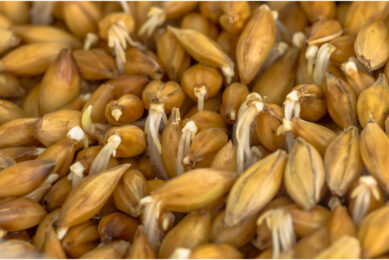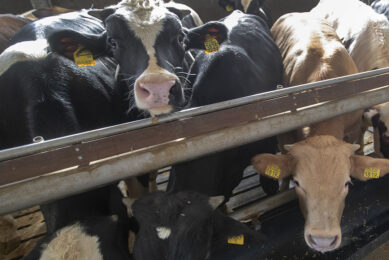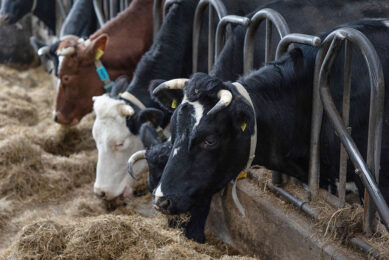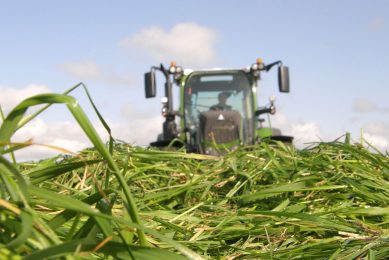Ensiled high-moisture grain: Better than its dry version?

There is sufficient scientific evidence to show that the nutritive value of ensiled high-moisture grain is similar to that of the corresponding dry grain for both ruminants and monogastric animals. Li Li reviews the data for cattle and pigs.
By Li Li
High-moisture grain is an alternative to conventional dried grain in livestock diets. After harvesting, the grain is rolled and a preservative is applied before ensilage (crimping).The benefits of high-moisture grain compared with dried grain include the opportunity to harvest when the nutritive value of the grain is highest, reduced in-field crop losses, cheap storage facilities, energy savings, high palatability, high nutritive value and similar or superior animal performance at lower cost compared with dried grain diets. The option to harvest 2-3 weeks earlier than normal benefits farmers because it enables earlier re-seeding of the subsequent crop, is less weather dependent and results in better quality straw.
Cow diets
Some early studies reported that high-moisture grain decreased the forage intake of dairy cows1. However, a more recent dairy cow trial conducted by Jaakkola et al. (2005) did not detect any difference in dry matter take when dry barley was replaced with ensiled crimped barley in a total mixed ration.
The reduced feed intake in the earlier trials may have been associated with the proportion of concentrate in the diet2. High-moisture grain may reduce feed intake if the amount of concentrate in the diet exceeds 50%. Several authors3have reported no differences in the yield and composition of milk from dairy cows when dry grain is replaced with ensiled high-moisture grain. One study reported that milk fat content was increased when cows were fed ensiled high-moisture grain4.
Based on these studies, it is concluded that ensiled crimped barley has the same nutritive value as dry barley for dairy cows. In beef cattle a higher daily live weight gain was observed5when bulls (initial weight, 145–220 kg; final weight, 480 kg) were fed ensiled crimped barley compared with dry barley (999 vs 908 g/d).
A more recent study6 compared beef cattle diets containing crimped, ensiled acid-treated wheat with diets containing conventionally harvested wheat treated with urea or propionic acid and showed no differences in live weight gain between the crimped, urea treated or propionic acid-treated diets at a final average weight of 620 kg.
Better FCR in pigs
There are few trials in which high-moisture grain has been compared with the corresponding dry grain for pigs. Siljander-Rasi (2001) fed dry barley or high moisture ensiled barley to piglets that had been weaned at the age of 30 d and had an initial live weight of 10.5 kg.
On a dry matter basis, the barley content of the diet was 45% for the first three weeks after weaning and 78.6% during the subsequent two weeks.
There was no difference between treatments in feed intake or daily live weight gain. The feed conversion ratio of piglets fed the high-moisture barley diet was superior to that of the piglets fed the dry barley diet (1.98 vs 2.02, respectively). The group fed the high-moisture crimped barley diet had fewer and less severe cases of diarrhoea than the group fed the dry barley diet. Few studies have compared the value of high moisture grain with that of the corresponding dry grain for growing pigs. Thomke and Tiden (1973) compared dry barley with moist barley in two trials with pigs.
In the first experiment, the initial weight was 22 kg and the slaughter weight was 91 kg; in the second experiment, the initial weight was 25 kg and the slaughter weight was 93 kg. In the first experiment, no differences were observed in daily weight gain, feed conversion ratio or meat quality between the high-moisture barley diet and the dry barley diet. However, in the second experiment, high-moisture barley was inferior to dry barley, mainly because a product containing formalin was included in the moist barley diet. In addition, the barley kernels were not thoroughly flattened, which decreased the digestibility of the diet.
Conclusion
Despite the obvious benefits of high-moisture grain compared with dry grain, it is not very popular among farmers. The main limitation to more extensive use of crimped grain for pigs and poultry is the difficulty of handling and feeding high-moisture grain. However, crimped high-moisture grain is appropriate for liquid feeding systems for pigs because of its high lactic acid content and the release of phosphorus from phytate.
Source: FeedMix vol 17 nr 4, 2009











